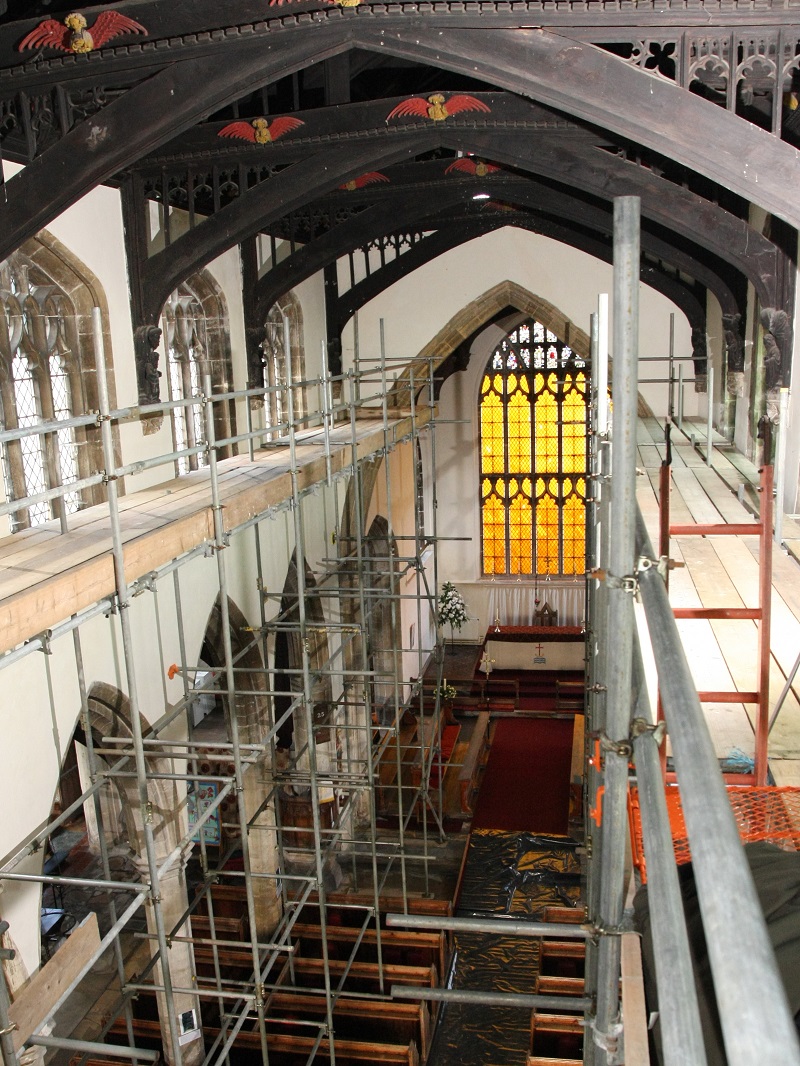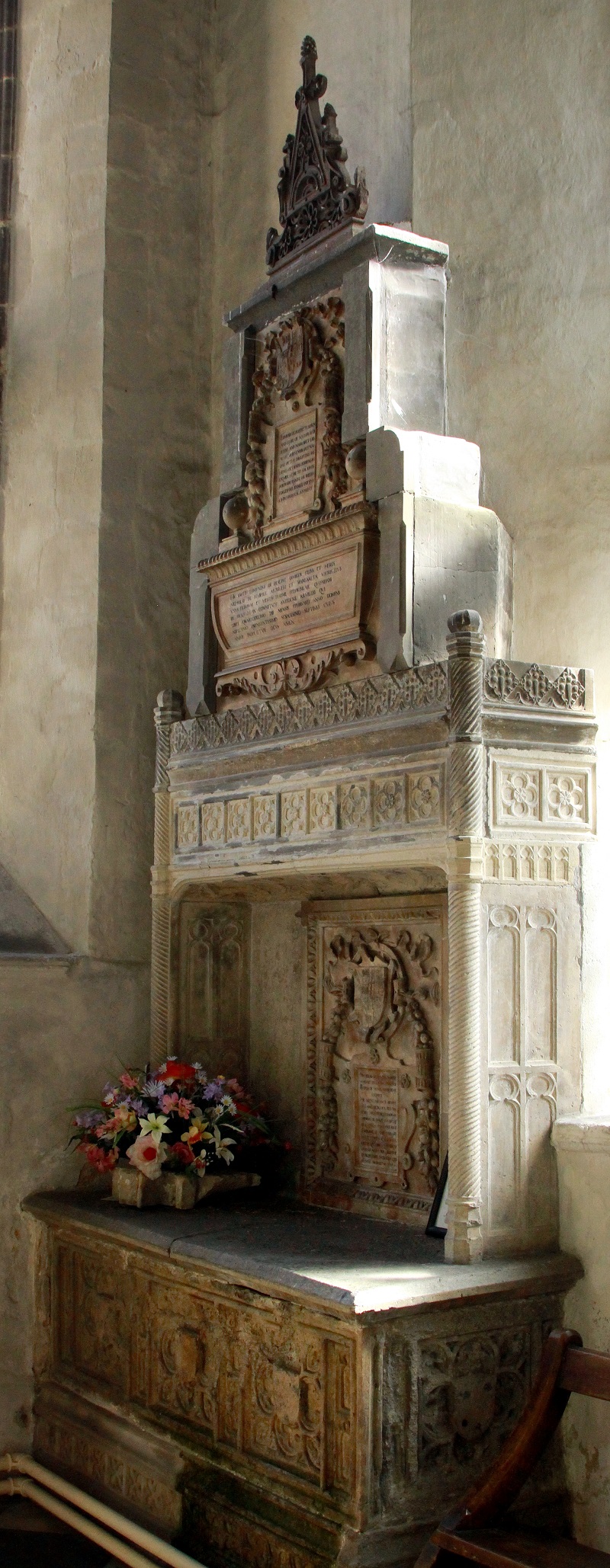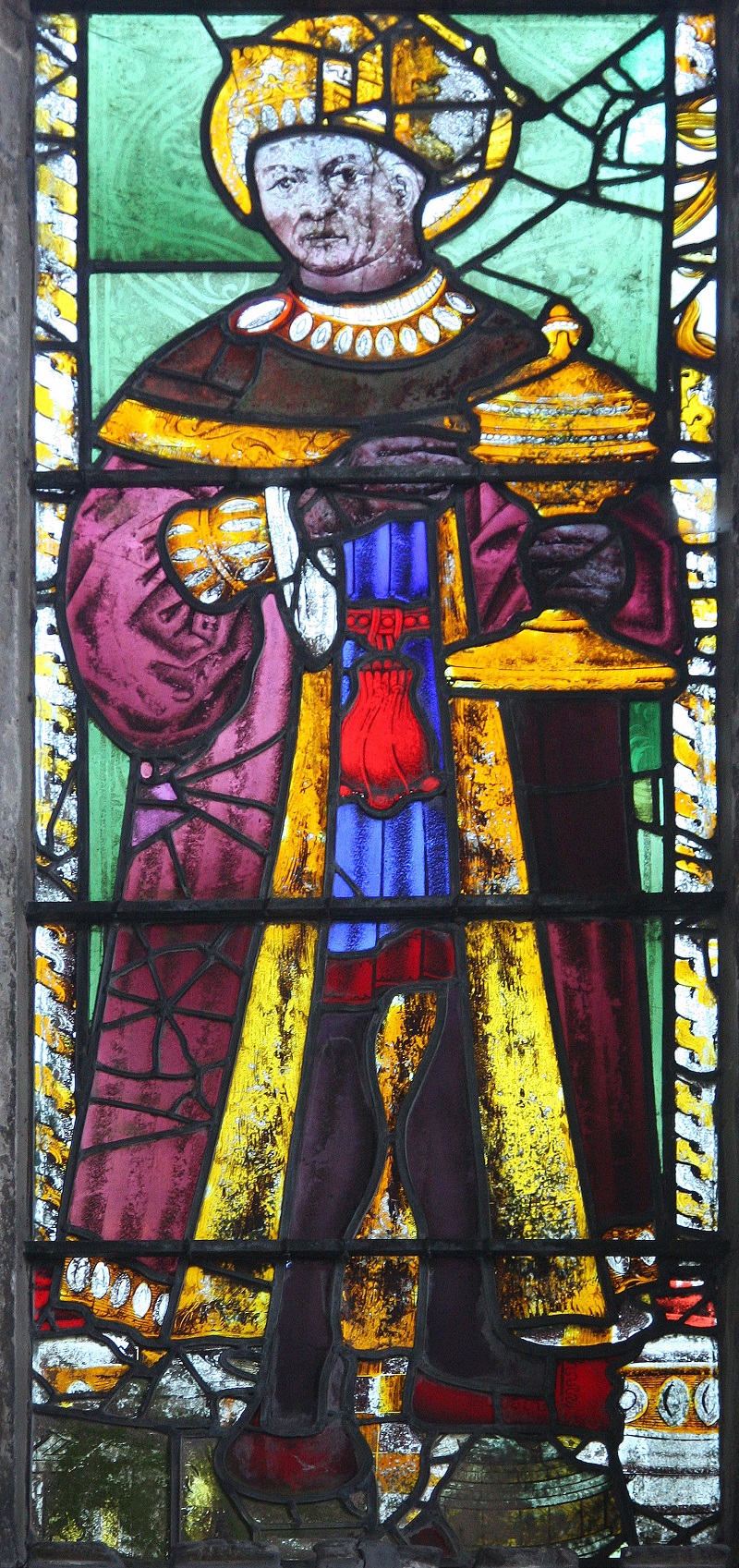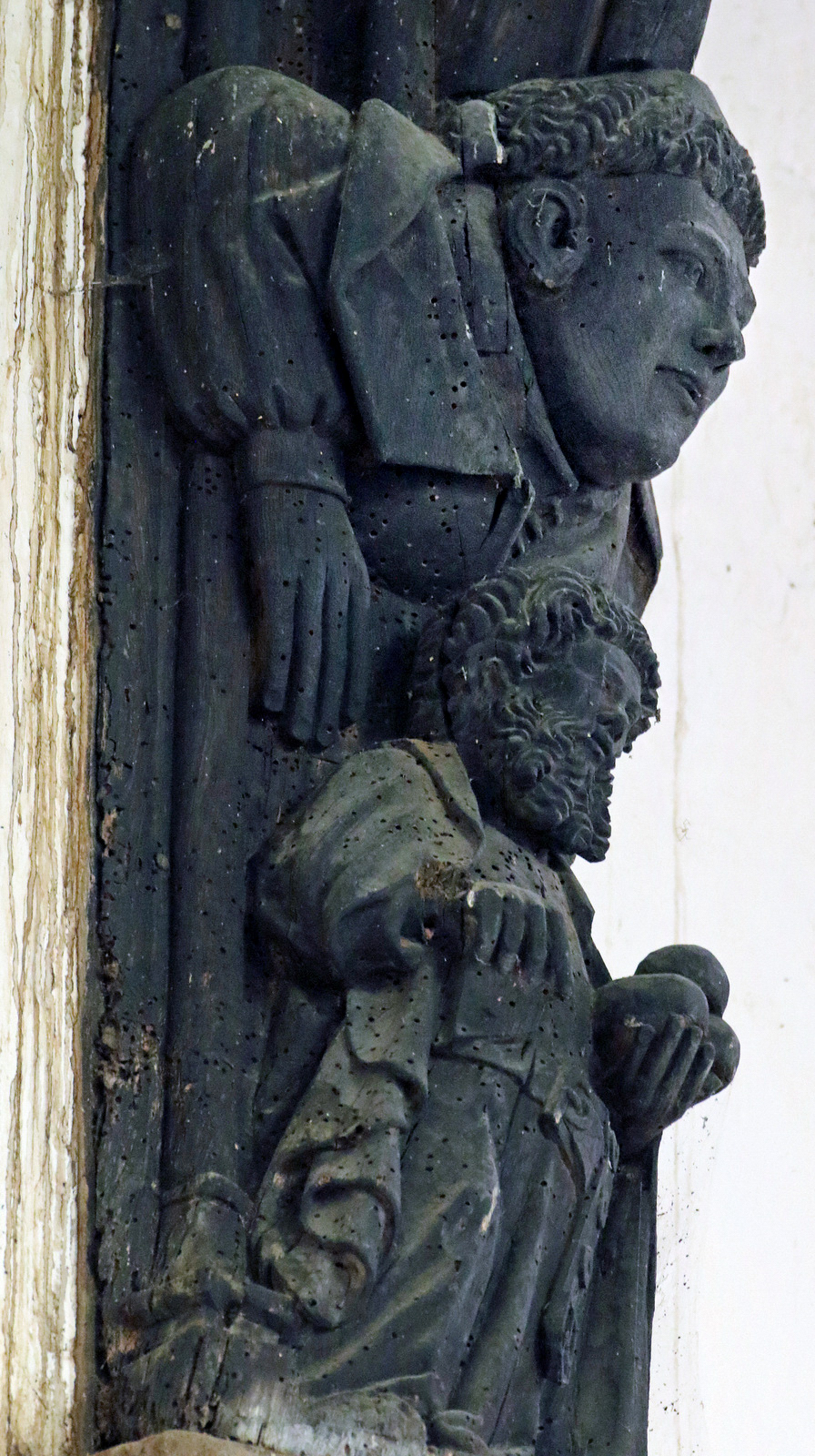Remembrance and Remonstrance
A Fenland Church
Claire Daunton
...and al my bokes as prikson boke gramer bokes englyshe bokes and al other be devidyd be twine my sonnes Edmonde and Nichols excepte I wil my primer remain in o[ur]lady chapel in outwell under lokke and key in a lytill deskewiche yf I leve I purpose to make for myself to sit inne and knele before sainte John and att pleasure of my nexte heres to have it borne in to my chapel. I geve also my portas to remain....also I will that iv coshons cov[er]yd with greys skinnys remain in the churche on my deske and iii upon my grave ston to sit on.Provisions made in Sir Nicholas Beaupre's will for St Clement's in 1513 |
Sir Nicholas Beaupre of Outwell, a village on the Cambridgeshire and west Norfolk border, was a man of detail, as his long and interesting will of 1513 makes clear. He wanted to leave nothing to chance. Very clear provisions were made concerning his land, his house and contents, and a range of other goods. He was concerned that his sons’ education and subsequent paths in life should befit their gentry status: he wished them to train in ‘the law’ as well as to concern themselves with the management of land. He had married well, to Margaret Fotheringhay, but it was more than a marriage for money and status: it was a close partnership, as the will indicates. His other concern was the parish church of St Clement, particularly the Lady Chapel, on the south side, where his family used to sit. He makes provision for repairs and repainting there and for hangings, as well as for a crimson cope (a cloak-like liturgical garment) for use in the chapel.
 |
|
| The 15th-century nave roof of St Clement's (Photo: Mike Dixon). |
The two quotations above, along with other detail from the will, make clear that he spent time in the church, to pray alone and take part in the liturgy, and that he liked to do this in a style befitting his status. But he was not a lover of great ostentation. There are marks of genuine piety in the will and of a genuine concern for the wellbeing of St Clement’s, as well as for the wider community of Outwell. He wished to be remembered as a devoted father, a devout Christian and a good member of the parish.
Sadly, nothing now remains of the desk, the cushions or the hangings, but there is a tomb to Sir Nicholas and his wife and heirs. There is also some very fine late medieval glass in the tracery lights of the east window in that chapel, probably dating to the period when Sir Nicholas entered into his marriage with Margaret. The scheme includes male and female martyrs of the early Church, but also figures of East Anglian saints such as King Edmund and King Oswald, alongside the arms of the then Diocese of Ely, with a background of crosses, suggesting the ‘crosses crosslet’ of the Beaupre coat of arms. No evidence survives of the family’s funding of the glass, but a close involvement with the choice of imagery seems more than likely. The window is one of the several glories of this fenland church that deserve to be better known.
The Beaupre family’s association with the church and the area went back more than two centuries: their gentry status was well established by the time that Sir Nicholas became head of the family in the late 15th century.
 |
|
| The tomb of Sir Nicholas Beaupre, his wife Margaret and their heirs (Photo: Mike Dixon) |
Another family responsible for the enrichment of St Clement’s was the Fynchams’. Although their association with Outwell began a little later, the Fynchams had already established themselves as patrons of the north chapel by the time Sir Nicholas was making his will.
John Fyncham (John was a common Fyncham name, just as Nicholas was a common Beaupre name) of Fincham St Martin, some 15 miles to the east, was the son of John Fyncham of Fincham and Beatrice Thoresby, daughter of one of the leading merchant families of Lynn. This John had also married well, to Elizabeth the daughter of Thomas Derham, sometime MP for Lynn. Although the Fynchams were landowners and members of the gentry, they were also a family of lawyers in a county notorious for its litigation and for the importance of lawyers, with close links to London.
John Fyncham, lawyer, who died in 1527, requested burial in St Bride’s Fleet Street, but he described himself as ‘John Fyncham of Owtewell in the countie of Cambrigge gentilman’.
The Fyncham chapel on the north side of the church, like that of the Beaupre chapel is noted for its architectural details but also for what remains of a fine early 16th-century glazing scheme which had depicted the visit of the Magi to the newly-born Christ. Only one figure, that of Balthasar bearing a gold cup, now remains below a set of Fyncham heraldic glass, pieced together during a programme of restoration. In his will John Fyncham requested that five gold cups be made for members of his family so that he might be remembered by these. It is interesting to note that in the original glazing scheme five gold cups were present.
The evidence in glass and stone of gentry families such as the Fynchams and Beaupres is one of the engaging aspects of St Clement’s, Outwell. Other elements of striking decorative work were surely provided by communal decisions and with communal fundraising: that which genuinely marks out St Clement’s, Outwell as unique is the composition of the imagery on the nave roof.
The roofs of the nave and aisles are filled with figures of angels, large and small (one count suggested 107 angelic figures), on roof beams and posts, carrying objects associated with the celebration of the Mass, instruments of the Passion of Christ, and symbols of episcopal and papal office. Probably dating from different decades of the 15th century, these angelic figures, their dress and the items they carry, are not unlike others found in East Anglian churches, although they are particularly rich in their range and number. The repair and upkeep of the nave and aisles was the responsibility of parishioners, so the choice and positioning of these angelic figures was likely to have been taken by a building committee of laity established by the churchwardens, probably with significant input from the clergy.
 |
| The restored figure of Balthasar in the north chapel (Photo: Mike Dixon) |
According to the work of the 12th century commentator William Durandus on liturgy and imagery in churches and their pre-figuring of heavenly existence, the higher up in the building and the closer to the chancel an image appeared, the closer its subject was to God. Thus, angels and apostles belonged on the roof. In Outwell the angels are in places you would expect to find them and so are figures of the apostles, on the roof posts; apostles in the company of the angels, but a little below them. What is different at Outwell, however, is that the apostles share their roof-post position not with angels but with others. Each figure of an apostle is accompanied by a figure of a human being or that of a devil; and some of the human figures are distorted. Now blackened with age and the heavy-handed application of dark-stained varnish, these roof-post figures are almost completely invisible to the naked eye. Their examination being a challenge makes uncovering their details all the more exciting.
On each of the 12 posts (six on the north side and six on the south side of the nave) a full-length figure of an apostle stands tall and straight. Several of these figures can be identified from items they hold, linking them with their life stories or their legends, well known to medieval viewers. Each figure is carved with care and skill allowing small details to be visible, such as buckles and holes on a belt, or the brim of a hat. The figures have an air of quiet stillness about them as they stand on small ledges formed by the ends of the roof posts. Above each full-length figure of an apostle is a half-length figure. These are formed into the curve of the roof structure. They are load-bearing and their shape and position makes them appear larger than the apostles. Shape, size and location are important. Some of these figures are human, some are demonic, some have dual characteristics, some are male, and some are female. No two are the same, but some have similar characteristics: there are two grinning demons, but they are not identical; there are two bourgeois merchant figures, but there are slight differences in their appearance; there are two men of the church, but one is a tonsured cleric and the other a cowled monk; there are two women, but one has a simple head-dress and carries rosary beads and the other has a rich, elaborate horned head-dress, but claws in place of hands. Although only half-length, these figures appear large, somewhat ungainly and somewhat distorted, in comparison with the precise, careful and upright figures of the apostles.
What to make of this roof-post scheme? There was an established tradition in East Anglia, particularly in manuscript illumination, for the juxtaposition of sacred and profane, for mixing the heavenly and the earthly. This trend can also be seen in other media in buildings. In the north east window of St Peter’s, Great Walsingham, for example, are images of human heads with grotesque features, the remains of a much larger 14th-century scheme mirroring those found in manuscripts. In the 15th century this type of imagery began to appear on bench ends and on roof friezes. A good example of the latter being on the nave roof at All Saints, Elm, Cambridgeshire and on the north aisle roof of Outwell’s near neighbour, St Peter’s, Upwell. Further, if we take one of the most striking of the figures, that of the woman with the horned head-dress and claws, we can see ‘sister’ figures in the church of St Martin, Fincham, some 15 miles to the west, and in St Mary’s, Mildenhall, some 30 miles to the south. Both places have either direct or indirect familial links to Outwell. At Fincham and Mildenhall, however, the figures do not have the detail of the claws and are not paired with apostles. In Outwell the normal order of things is turned upside down.
| Details of some of the double figures on the roof posts with an apostle on each: a tonsured cleric and a demon with St John (Photos: Hugh Harrison) | |
 |
|
In the north aisle of St Mary’s, Mildenhall there are roof-post pairings of angels and apostles, but here, true to Durandus’ treatise, the figure of the angel stands higher than the apostle, inclining in a protective manner. In Outwell when seen from the floor of the nave (the view parishioners would have had), the larger half-length figures appear to loom over and overwhelm the smaller figures of the apostles. When viewed at eye level, or roof level, the pairing seems completely different: the larger figures are bearing the weight of the roof, are worn down by it and appear much more vulnerable than the free and straightbacked apostles. The larger figures are in fact not larger; they are more bulky perhaps, but also more encumbered.
This scheme begs a great many questions which, in the absence of surviving documentation, have no clear answers. Some interesting points, however, arise from the apparent ambiguities in both the content of the scheme and its location on the roof. Making comparisons with surviving images of figures in brass, stone and glass, we can date the roof scheme to the middle years of the 15th century, a period when many churches in East Anglia were being restored or enlarged. It was common for roof levels to be raised and for the new roofs to have decorative figure schemes.
Projects of this nature would have involved fundraising campaigns, building committees and the involvement of leading families of the parish. They would have engaged craftsmen from the locality or further afield, according to their finances and the availability of skilled labour. Some of the most skilled teams, associated with the Benedictine abbey at Bury St Edmund’s, would have been familiar with a wide range of imagery, and the literature from which this was derived.
We know that a range of devotional and didactic literature was in circulation at this period, available to the clergy and to the literate laity. It included treatises that dealt with the virtues and vices, with preparing for a good death by living a holy life, exhorting congregations to put aside the animal side of nature and look to things spiritual. Some of these treatises painted vivid word pictures translated by carpenters and masons into visual imagery in wood and stone. It is possible then that a building committee at Outwell, or one or two leading parishioners, might have agreed that the new roof needed a didactic scheme that illustrated how men and women from different walks of life and social stations were prey to temptations, and that these temptations could be understood as physical distortions. By contrast, the apostles are now saints and have therefore been purified of the disfigurements of sin. Such a scheme would have been up-to-date with the contemporary literature and would have had much to recommend it both in didactic terms and in its visual impact.
Those commissioning such a scheme, novel in itself, could not have known how it would turn out in practice. The fact that it was not repeated elsewhere suggests either that it was a disappointment to those who commissioned it, or that its message was too forthright. Perhaps the roof figures reminded parishioners of those around them and their human traits and foibles; and one can see, perhaps, a deliberately playful and enigmatic element in this scheme.
We can gain some idea of the impact of the new roof scheme at Outwell from the recently restored roof at St Mary, Beeston-next-Mileham, Norfolk. Here the pale oak is bright, and the impact of the carved figures is clear from floor level. There are figures of angels, saints and clerics, but also of birds and animals. What is now blackened by age and hidden from the naked eye at Outwell would have been visible, perhaps not in every detail but the message of the scheme would have been there for parishioners to see. Were they puzzled, disappointed, outraged? Or was it the case that in fact not all the details were so clear and some of the impact of the scheme, its full message, was blunted? Or were the master carpenters putting their own interpretation on instructions and did the scheme turn out to be either more or less in its impact than the building committee and its backers intended? While the figures of saints and angels in other parts of the church provided comfort and familiarity, the figures on the nave roof remonstrated, challenged, amused and reminded those who viewed them that there was a saint and a sinner in each of them.
This is a remarkable, beautifully executed scheme, in a church full of interesting imagery and artefacts, lovingly supported by a small community. The figures have survived since the 15th century but they are now in grave danger from damage accumulated over the centuries. The Friends of St Clement’s and the church’s parishioners have been working hard over the past decade to raise funds for restoration of the roof, the late medieval stained glass and other aspects of this special place.
Further Reading
For details of The Friends of St Clement's and how to support their work of caring for the church, see www.stclementsoutwell.org.uk. Photos are reproduced by kind premission of Mike Dixon, Norfolk and of Hugh Harrison, Conservation Consultant, Devon.



